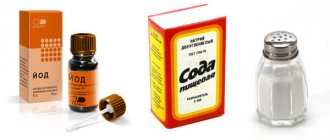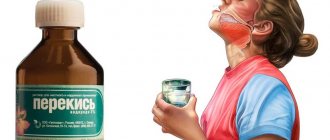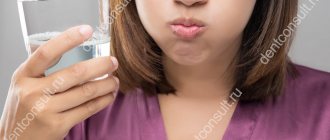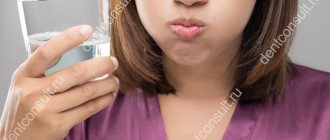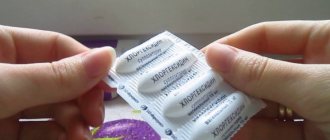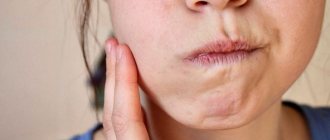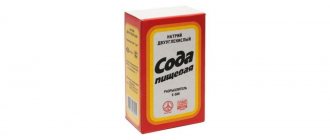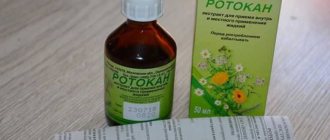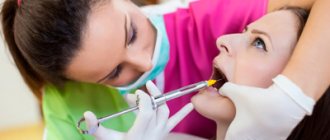12/21/2021
57 809
13 minutes
Author, editor and medical expert – Klimovich Elina Valerievna.
Editor and medical expert – Harutyunyan Mariam Harutyunovna.
Despite the variety of general drugs, local therapy for dental and ENT diseases is of great importance. In particular, doctors recommend rinsing the throat and mouth with antiseptic solutions as one of the important components of complex treatment3,4.
The search for methods to combat infections has led to the creation of new drugs. Today, “improvised” remedies such as salt and soda, when gargling, are replacing highly effective drugs that help quickly cope with inflammation, soreness and pain in the throat, and relieve coughs caused by irritation and inflammation of the inner lining of this part of the respiratory tract.
Up to contents
General principles of rinsing
Its undoubted advantage is the lack of systemic action. The components of the solutions are practically not absorbed, do not penetrate into the general bloodstream, and do not affect the functioning of the organs and systems of the body3,4. This allows the procedure to be used not only in the treatment of adults, but also in children and pregnant women3.
The generally accepted local procedure has a versatile effect.
- Mechanical cleansing of the mucous membrane. More precisely, its disposal of pathogenic microorganisms, mucus and pus, which contains pathogens and toxins formed as a result of their vital activity 3.4. By the way, this basically limits the effect when gargling with soda for a child or adult.
- Antiseptic effect. Pharmaceutical preparations contain components that have a detrimental effect on most bacteria, viruses and fungi, which most often cause diseases of the pharynx and oral cavity4,5.
- Creating conditions unfavorable for the proliferation of microbes. The normal acidity of human body tissues ranges from pH 7.32 to 7.45, which corresponds to an alkaline environment. Inflammation, especially purulent inflammation, is accompanied by acidification of tissues and a decrease in pH to 6.5-5.39, which contributes to the further development of infection1. Many rinses alkalize the environment and create conditions unfavorable for the development of viruses and bacteria1, but the majority of drugs inhibit the growth of bacteria due to the action of their antiseptic component3.4.
- Pain relief. Of course, when gargling with baking soda, you can’t really count on relieving a sore throat. But the use of pharmaceutical preparations specially designed for this purpose, containing local anesthetics, can significantly alleviate suffering3,4.
- Reducing signs of inflammation. The action of the medicine leads to a decrease in swelling, pain and redness of the inflamed mucous membrane. At the same time, discomfort in the oral cavity, sore throat and cough caused by irritation of the receptors of the upper respiratory tract are reduced.
- Thinning mucus and making it easier to expectorate4. Some solutions dilute sputum by shifting the pH of mucus to the alkaline side, others contain special components that reduce the viscosity of mucus and thereby facilitate its removal4.5.
Up to contents
Precautions and contraindications
If the recommended proportions are not observed, substances can have a number of negative effects on the body. There are also contraindications to treatment with the composition.
Exceeding the dosage of sodium chloride and bicarbonate leads to the following adverse reactions:
- Fluid retention in the tissues of the oropharynx. Excessive amounts of salt provoke swelling of the mucous membranes.
- Imbalance of potassium and sodium, leading to dysfunction of the myocardium, the appearance of tachycardia and increased blood pressure.
- Improper functioning of the gastrointestinal tract. The appearance of dyspepsia in the form of belching, heartburn and other manifestations.
Contraindications to the use of the medicinal composition include the following conditions:
- Gastritis, manifested stomach disease;
- Arterial hypertension;
- Jades;
- Hemorrhagic diathesis;
- Not recommended for persons with hypersensitivity to substances;
- First trimester of pregnancy.
Rules for the procedure
In order for rinsing to be beneficial, you need to adhere to certain rules3 in the use of ready-made preparations and the preparation and use of solutions from them.
- The proportions of the components must be strictly observed. The question “how much baking soda to gargle” is perhaps one of the most popular on the Internet. It disappears if you use ready-made pharmaceutical preparations that no longer need to be diluted with water - these are the ones most often recommended by doctors.
- The solution should not be cold or hot - only warm3,4. For this reason, there is no need to keep medications in the refrigerator.
- Follow the instructions for the duration of the procedure - this ensures the necessary contact of the active components of the drug with the mucous membrane3.
- Follow the manufacturer's recommended frequency of treatments to ensure continuity of treatment. The components of the drug retain their activity at the site of inflammation for a limited amount of time.
- Try not to swallow the product. Of course, there will be no poisoning in any case, but still, rinsing preparations are not intended for oral administration.
- For half an hour after the procedure, drink nothing and do not eat food3,4. This is important to prolong the contact of the drug with the affected mucous membrane.
Up to contents
How to rinse correctly
With the first portion of the freshly prepared composition, they first rinse the mouth, and then proceed to the throat, holding the medicine for about 30 seconds, after which they spit.
After the manipulation, you must abstain from food for about an hour.
It is best to rinse with this composition in the morning after breakfast and in the evening before going to bed.
Indications for the procedure
Doctors recommend the procedure for the following diseases 3,4,5.
1. Sore throat (acute tonsillitis).
Acute tonsillitis is an infectious disease accompanied by inflammation of the tonsils. In children aged 3 to 7 years, bacteria are the cause in 77% of cases3,7. In adults, most sore throats are caused by viruses4, but subsequent activation of bacterial microflora leads to the development of a bacterial inflammatory process4.
In severe cases of tonsillitis, doctors immediately prescribe antibiotics3,7; local therapy complements general therapy and helps cleanse the tonsils. In mild cases of the disease, accompanied by moderate intoxication, low fever, slight redness and swelling of the tonsils and their arches, only local therapy is sufficient3. Of course, in such cases we are not talking about gargling with a soda solution - only about antiseptics specially designed for this.
Pharyngitis
Acute pharyngitis, or inflammation of the pharyngeal mucosa, is rarely isolated4. In the vast majority of cases it develops as part of the clinical picture
nasopharyngitis, that is, in addition to rhinitis during ARVI, or tonsillopharyngitis - in combination with inflammation of the tonsils4.
Viral pharyngitis is more common than bacterial pharyngitis. In this case, inflammation caused by viruses dominates only at the very beginning of the disease. Hypothermia, drinking cold drinks, inhaling dusty and chemically contaminated air, smoking and other factors that lead to irritation of the mucous membrane of the respiratory tract and decreased immunity often lead to the activation of opportunistic bacteria and the development of bacterial inflammation4. Isolated pharyngitis rarely takes a severe course, so systemic therapy is used only in exceptional cases4.
More often, doctors recommend local therapy - gargling.
Candidiasis of the oral cavity and pharynx
Yeast-like fungi of the genus Candida can be found in most people3. This microorganism belongs to the opportunistic representatives of the microflora and is activated only when immunity decreases3. The development of candidal stomatitis and pharyngomycosis is facilitated by intestinal dysbiosis and such severe general diseases as diabetes, cancer, and HIV infection. In addition, candidiasis often develops against the background of long-term use of antibiotics, as well as due to improper use of local glucocorticoids (sprays) for bronchial asthma3.
Small white “islands” appear on the mucous membrane, which increase in size and, merging, form films. Externally, the films resemble pus, but they are not removed; when they are rejected, red spots and erosions remain on the surface of the mucous membrane3. Swallowing liquids and food causes pain, which causes adults to lose their appetite, and small children to refuse to eat altogether. Along with antifungal agents, microflora-restoring prebiotics and probiotics, and immune-strengthening medications, local therapy is used3.
Up to contents
Solution "OKI": instructions for use
To treat joint diseases, prepare a solution and take it orally. The instructions are simple:
- Take 1 sachet.
- Dissolve the contents in half a glass of water.
- Visually divide the volume into 3 parts and drink 3 times a day while eating.
Adults take the full dosage, children take half the dose. It is advisable for elderly patients to consult a doctor; the dose may be adjusted downward.
Does gargling with baking soda help?
To carry out the procedure, use ordinary baking soda, which is found in almost every kitchen. In terms of chemistry, it is the sodium acid salt of carbonic acid with the formula NaHCO3 (sodium bicarbonate)2.
Sodium bicarbonate, as an active ingredient, is in the register of medicines2. Indications for its use include acute infections of the upper respiratory tract and inflammatory diseases of the oral cavity2. It also describes its action and indicates how much soda is needed to gargle. However, it must nevertheless be recognized that as a means of local therapy for tonsillitis, pharyngitis and stomatitis, it is hopelessly outdated. Its mentions are rare and found in medical articles dating back to the last century. Experts who keep up with the times excluded it from their recommendations. Sodium bicarbonate is not only ineffective, but also not as safe as it might seem at first glance5.
Why shouldn't you use baking soda?
- Questionable effect. Statistics show that 90% of patients who turn to ENT doctors with pharyngitis independently and repeatedly gargle and, nevertheless, they had to resort to medical help5.
- Violation of natural defense mechanisms. The mucus produced by the glands of the pharynx performs a protective function. Microbes that get inside “get stuck” in mucus, lose their activity and partly die under the influence of biologically active substances - interferon, immunoglobulins, lysozyme and others. When rinsing, mucus is washed away, as a result of which the mucous membrane becomes dry, vulnerable and vulnerable to bacterial viruses5. From this point of view, it is probably better to use antiseptics for the procedure, which not only remove mucus, but also kill pathogenic microbes.
- Dryness of the pharyngeal mucosa. This is especially true for chronic pharyngitis, accompanied by thinning of the inner lining of the pharynx and decreased mucus secretion7. Sodium bicarbonate dries out the mucous membrane even more and thereby opens the entrance gates to bacteria that live in the upper respiratory tract and enter through the nose and mouth.
- Effect on stomach acidity. This mechanism is realized when the sodium acid salt of carbonic acid enters the stomach, which often happens in children who do not know how to gargle. By reacting with the hydrochloric acid of gastric juice, sodium bicarbonate literally immediately reduces the acidity of the stomach6. However, soon it not only recovers, but also becomes higher compared to the initial level. This is due to irritation and increased activity of acid-producing cells6. It is because of this that it is not used as an antacid, that is, a means to reduce stomach acidity6. Soda can be dangerous for people with hyperacid gastritis, gastric and duodenal ulcers, as well as for children with underdeveloped protective mechanisms of the digestive system6.
- During pregnancy. The specific taste of soda can provoke vomiting in pregnant women, which is associated with a physiological increase in the gag reflex. In addition, in late pregnancy, when many pregnant women suffer from heartburn, sodium carbonate entering the stomach can cause increased symptoms6.
- Acidosis. Of course, for the development of acidosis, that is, a violation of the acid-base state of the body, accompanied by acidification, you need to take much more soda orally than is needed for gargling. However, we cannot ignore this complication. Even a short-term shift in acid-base status in patients with renal failure can significantly worsen the condition2. In patients with heart disease, it provokes the appearance of edema and the development of heart failure2.
Self-medication is, in principle, dangerous to health, and taking into account all of the above, it is better to remove soda from the medicine cabinet and not use it even for adults. But the question deserves special attention: is it possible to gargle with soda for a child? Due to their age and lack of skills in performing the procedure, young children often swallow solutions5. They are at higher risk of developing sodium bicarbonate side effects than adults5. Special products have been created for children5 in the form of sprays with antiseptic and anti-inflammatory components - these are in the HEXORAL® line of drugs.
Up to contents
Instructions for use of candles
Suppositories are also used to treat joint diseases. They are administered rectally; the quantity and frequency of administration depends on the patient’s age:
- Children under 12 years old - 1 suppository with a dosage of the active substance of 60 mg 1 or 2 times a day.
- Children over 12, but under 18 years old - the same with an increase in the total amount up to 3 times in essence.
- Adults – 1 suppository 2 or 3 times a day.
- Elderly patients - 1 suppository 1 or 2 times a day.
Attention!
The duration of the course of treatment is determined by the doctor. Children and adolescents can take suppositories for no more than 5 days in a row.
special instructions
Taking OKI in the form of a rinse solution does not affect the ability to drive a car or operate machinery, since it does not reduce reaction and performance. However, when taking the drug orally, as well as suppositories, inhibition is possible, so it is better to refrain from such activities.
If during the course of "OKI" the patient becomes infected with an infection, he may not have the corresponding symptoms for some time, since the drug masks them.
If the patient has persistent dysfunction of the liver and kidneys, the dosage of ketoprofen should be reduced. There is also a risk of an asthma attack. In such cases, taking the medicine is allowed only in consultation with the doctor. If a woman is planning a pregnancy, it is better for her to refrain from using OKI orally and use alternative drugs.
Other methods for treating gums at home
- Oral baths with decoctions and tinctures, which include Kalanchoe, chamomile, St. John's wort, calendula and other anti-inflammatory herbs and extracts.
- Special diet - just increase the number of foods that contain a large amount of calcium (cheese cheese, cottage cheese, beans, almonds, etc.) and vitamin C (orange, kiwi, strawberries, black currants, etc.).
- To give up smoking. Cigarettes worsen the condition of teeth and gums and provoke the development of inflammation.
Home methods for treating gums bring good results, but they can never replace full-fledged dental treatment.
Treatment of gums with salt
Causes of gum inflammation
Why salt helps
How to properly rinse your mouth with saline solution
Salt gum massage
Other methods for treating gums at home
Bleeding gums, increased sensitivity and bad breath indicate that your gums are not healthy. Why do they become inflamed? Is it necessary to see a doctor or can they be strengthened at home? How to use salt to relieve inflammation? Read more in the article.
Can it be used during pregnancy?
Regarding the best way to rinse your mouth during pregnancy, you should definitely consult your dentist. It is not prohibited to use a soda-salt solution during this period, however, all precautions must be taken and if a pronounced gag reflex appears, stop the procedure immediately.
You also need to take into account that sometimes the combination of salt, soda and iodine gives an allergic reaction. Solutions with added iodine are generally not recommended during pregnancy. Do not exceed the dosage prescribed by the doctor so as not to provoke complications.
During pregnancy, you should be wary of any treatment methods.

